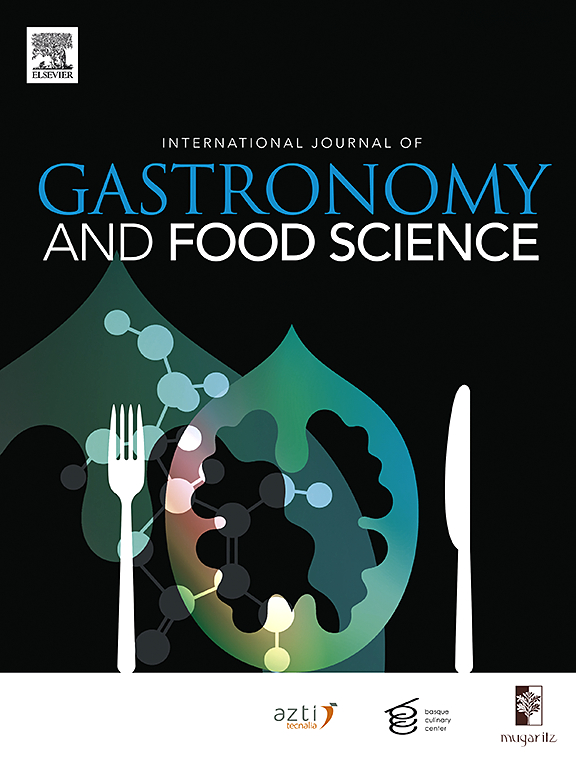不仅仅是文字:16 - 20世纪欧洲美食的文学反映
IF 3.6
2区 农林科学
Q2 FOOD SCIENCE & TECHNOLOGY
International Journal of Gastronomy and Food Science
Pub Date : 2025-07-15
DOI:10.1016/j.ijgfs.2025.101247
引用次数: 0
摘要
本研究考察了美食与文学之间的复杂关系,重点是在大众媒体上出版的被归类为世界经典的书籍。它分析了16世纪到20世纪欧洲饮食文化的转变。通过对17部开创性文学作品的定性文本分析,该研究探讨了食物和饮料是如何表现的,包括它们对社会、烹饪工具、厨房设备和烹饪技术的影响。研究结果表明,人们经常提到的就餐场所包括小酒馆、厨房和餐厅,而鱼类和海鲜则是人们经常提到的肉类产品。奶酪是最常见的乳制品,面包是主要的面食。俄罗斯是最常提到谷物产品的国家。此外,白菜、土豆和洋葱在四个国家的作品中一直是重点。与此同时,法国以强调各种水果和甜点而闻名。在饮料中,啤酒和葡萄酒是被提及最多的酒精饮料,而茶、咖啡和牛奶是最普遍的无酒精饮料。通常被引用的工具包括杯子、盒子、篮子和高脚杯,沸腾和油炸技术也被广泛描述。最后,这项研究强调了文学作品在记录和保存美食遗产方面的作用,为历史烹饪传统提供了宝贵的见解。本文章由计算机程序翻译,如有差异,请以英文原文为准。
More than words: Literary reflections of European gastronomy in the 16th–20th centuries
This study examines the intricate relationship between gastronomy and literature, focusing on books categorized as World Classics published within mass media. It analyzes the transformation of food and beverage culture in Europe from the 16th to the 20th centuries. Through a qualitative text-oriented analysis of seventeen seminal literary works, the research explores how food and beverages are represented, including their impact on society, culinary tools, kitchen equipment, and cooking techniques. The findings indicate that commonly referenced dining venues include taverns, kitchens, and dining rooms, while fish and seafood dominate as frequently mentioned meat products. Cheese appears as the most common dairy product, and bread is the predominant dough-based item. Russia emerges as the country with the most frequent references to cereal products. Additionally, cabbage, potatoes, and onions are consistently highlighted across the four nations’ works. France, meanwhile, distinguishes itself with its emphasis on a variety of fruits and desserts. Among beverages, beer and wine lead as the most mentioned alcoholic drinks, while tea, coffee, and milk are the prevalent non-alcoholic choices. The tools commonly cited include cups, boxes, baskets, and goblets, with boiling and frying techniques being widely described. Ultimately, the study underscores the role of literary works in documenting and preserving gastronomic heritage, providing valuable insights into historical culinary traditions.
求助全文
通过发布文献求助,成功后即可免费获取论文全文。
去求助
来源期刊

International Journal of Gastronomy and Food Science
Social Sciences-Cultural Studies
CiteScore
5.30
自引率
10.50%
发文量
170
审稿时长
45 days
期刊介绍:
International Journal of Gastronomy and Food Science is a peer-reviewed journal that explicitly focuses on the interface of food science and gastronomy. Articles focusing only on food science will not be considered. This journal equally encourages both scientists and chefs to publish original scientific papers, review articles and original culinary works. We seek articles with clear evidence of this interaction. From a scientific perspective, this publication aims to become the home for research from the whole community of food science and gastronomy.
IJGFS explores all aspects related to the growing field of the interaction of gastronomy and food science, in areas such as food chemistry, food technology and culinary techniques, food microbiology, genetics, sensory science, neuroscience, psychology, culinary concepts, culinary trends, and gastronomic experience (all the elements that contribute to the appreciation and enjoyment of the meal. Also relevant is research on science-based educational programs in gastronomy, anthropology, gastronomic history and food sociology. All these areas of knowledge are crucial to gastronomy, as they contribute to a better understanding of this broad term and its practical implications for science and society.
 求助内容:
求助内容: 应助结果提醒方式:
应助结果提醒方式:


